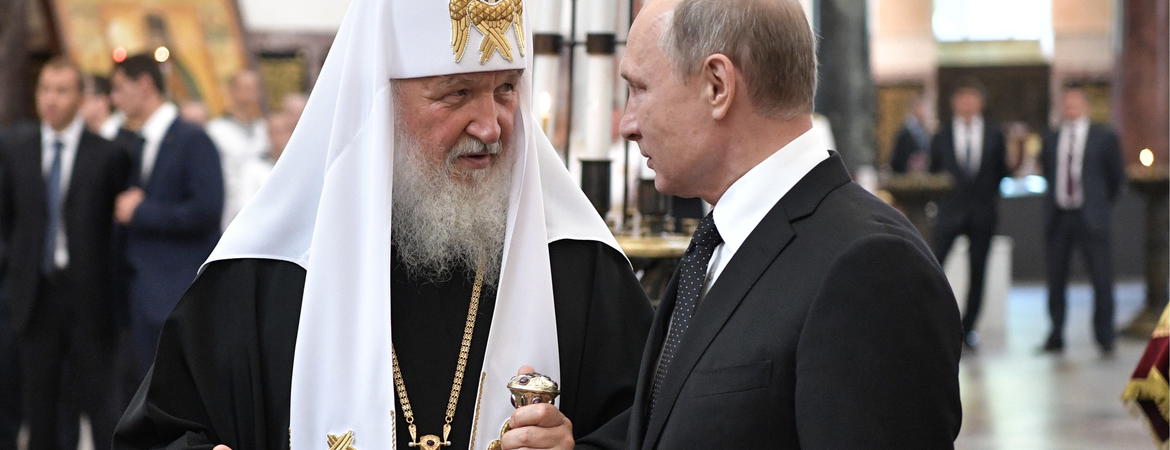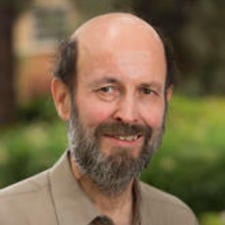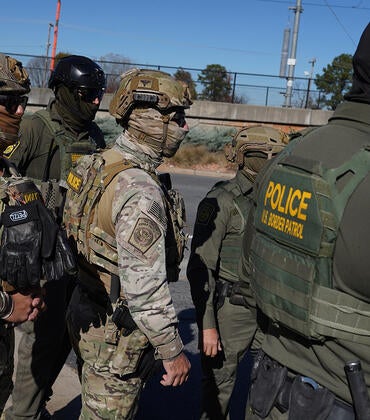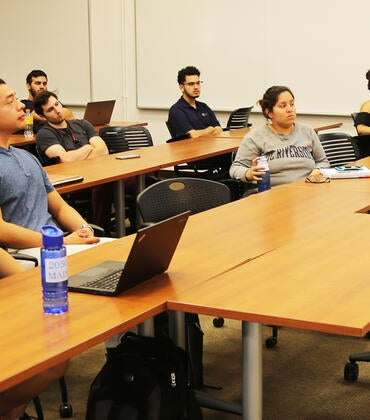
The public dialogue about the Russian invasion of Ukraine has been dominated by 20th-century historians and political scientists, according to UC Riverside Department of History Professor Georg Michels. Michels, who specializes in early Russian, Ukrainian, and Hungarian history, acknowledges the relevance of 20th century history, including World War II analogies and Stalinist influences, in framing the present discourse. But Michels said a look further back into Russian history is required to appreciate the sense of destiny that drives Vladimir Putin, with his purposefulness rooted in ages-old Ukrainian-Russian dynamics. Michels' publications include "At War with the Church: Religious Dissent in Seventeenth-Century Russia," published in 1999 by Stanford University Press. He received his Ph.D. from Harvard University in 1991.
Q: What is the perspective of the Russian Orthodox Church on the war in Ukraine?
A: At the beginning of the war Patriarch Kirill, the leader of the Russian Orthodox Church, gave a sermon in which he emphasized the God-given unity of Ukraine and Russia; he also denounced the “evil forces” in Ukraine that are out to destroy this unity. Last Sunday (March 6) he sounded even less conciliatory. Invoking the intercession of two of medieval Russia’s most important saints, “Holy Prince Vladimir” and Sergei of Radonezh, he called on God to “prohibit and overturn the designs of the foreign pagans [sic] who want war and are gathering troops against Holy Russia.” He called on God to bless the Russian soldiers sent to protect Russian Orthodox Christians in the Donbass region (Eastern Ukraine) who have been suffering oppression and persecution for eight years. But much more is at stake than the liberation of the oppressed Russians, he said: the salvation of mankind — people are weak and no longer following God’s Law, they are no longer hearing His Word and His Gospel, they are blind to the Light of Christ. The future of human civilization itself is at stake; then the patriarch went into an angry tirade against gay parades … which he characterized as a great sin against God. In fact, he said, participation in such parades demonstrates a clear denial of God and His Truth. This is how Kirill speaks; he appears to believe that Orthodox Russia, or Holy Russia as he calls it, is engaged in an apocalyptical struggle with the Godless West about the future of mankind. In fact, in last Sunday’s sermon he invoked the Last Judgement and the Day of Reckoning.
Q: Why does Patriarch Kirill not intervene with Putin to stop the war?
A: It is stunning to see that the patriarch has remained completely passive although representatives of western churches have repeatedly called on him to speak to Putin (most recently the papal nuncio). A petition by more than 150 Russian Orthodox priests and monks calling on Kirill to denounce the war has also remained unanswered. Apart from the apocalyptic sermons mentioned above, Kirill seems remarkably disengaged. The daily pronouncements of his office suggest that there is no war in Ukraine but only a refugee crisis; the reasons for this crisis are not explained but parishes and monasteries are called upon to open their gates to refugees. It seems that all the refugees are persecuted Russians; the church thus embraces the official view that Russians are being persecuted by Ukrainians. Interestingly enough, the church is not only taking in refugees that have fled into Russia (ca. 18,000) but also those internally displaced inside Ukraine. The diocese of Odessa, for example, is said to be distributing humanitarian aid to anyone who needs it; psychological counseling is also offered; even help from Romania and Germany is welcome and distributed by churchmen. How this is supposed to happen in Ukraine where the Russian Orthodox Church has been largely discredited remains a puzzle to me.
Q: How important are Russian Orthodoxy and the Russian Orthodox Church for Putin?
A: Very important. The Russian Orthodox Church is providing much of the symbolism and ideology that Putin has used to cement his popularity. When he faced his first election campaign to become Yeltsin’s successor in early 2000, he revealed to the public that he had been baptized secretly by his mother; in fact, his mother told everyone on television how she had gathered her courage to get little Putin baptized in 1952, that is, one year before Stalin’s death. Putin, whose macho displays of shirtless manhood are well known, is actually wearing a silver cross around his neck; a gift from his mother. In one of his most spectacular displays of masculinity, he submerged himself in an icy lake during the Orthodox Festival of Epiphany; this can be seen on a video that prominently shows Putin’s cross. Putin has been flaunting his religious faith; he is often seen on television praying, crossing himself, kissing icons, and lighting candles. Priests have held ceremonies to bless Putin, and Patriarch Kirill has called Putin “a miracle of God.”
Putin’s Orthodoxy is less about spirituality and faith than about religious performance. It derives from the Kremlin’s mythologization of Russia’s historical past. One of Putin’s first acts was to convince the church to canonize the last Romanov tsar and his family; and clearly the empire created by Peter the Great is very much on Putin’s mind. But Peter’s empire was actually built at the expense of the church; Peter abolished the patriarchate and integrated the church into the state apparatus. Putin’s real concern is with the medieval empires of Kiev and Moscow; they are providing most of the symbols and rituals of Putin’s power.
Q: Why is Medieval Russia so important to Putin?
Putin is, of course, not the first 20th century Russian ruler for whom medieval Russia was important. Stalin initiated two of the Soviet Union’s largest film projects about medieval figures. The great filmmaker Sergei Eisenstein was commissioned to make films about Prince Alexander Nevsky and Tsar Ivan the Terrible; these are clearly propaganda films but nevertheless masterpieces of world cinema that I regularly show to my students. Both Nevsky and Ivan are portrayed as heroic military figures who destroyed foreign invaders and occupiers of the Russian lands. Nevsky supposedly defeated the Teutonic knights who are said to have invaded Russia in the 13th century. A famous line from the film reads something like “who comes to Russia with the sword will perish by the sword.” And when Alexander leads his troops into battle against the Germans the battle cry was “Za Rus’” (“For Russia”). The film was completed before the Hitler-Stalin pact of August 1939 and it was immediately shelved. However, when the Germans invaded in June 1941, the film became a blockbuster watched by millions of Russians, many of whom did not survive the war.
Putin shares with Stalin the adoration of Alexander Nevsky and Ivan the Terrible. Yet, it is not just the military prowess of these medieval figures but also their militant defense of Russian Orthodoxy that is important. Alexander Nevsky is not only one of Russia’s greatest national heroes but also among its most important saints.
Why did Alexander become a saint? For two reasons: first, for defending Russia against the perceived onslaught of the Catholic church; the Teutonic knights were after all a crusading order. Second and perhaps more importantly, for giving Metropolitan Kirill of Kiev, the head of the Orthodox Church, a new home after he had been expelled from Kiev by the Mongols. He thus facilitated — so goes the common nationalist narrative — the migration of Holy Russia from Kiev to Moscow.
Q: What is the historic significance of Kiev/Kyiv for Russian Orthodoxy and Putin?
A: A close look at Patriarch Kirill’s choice of words during his Sunday sermon reveals that he equates “Holy Russia” with “Holy Rus’’ (Sviataia Rus’). The medieval state of Rus’ was founded in the 9th century by Vikings to control trade routes connecting Scandinavia with the Byzantine Empire (Constantinople) and the Abbasid Empire in the Middle East (Baghdad). The capital of this Viking state was Kiev; in the year 988 the ruler of Kievan Rus’, the Viking Prince Woldemar, converted to Eastern Orthodoxy on Crimea and adopted the Christian name Vladimir. He later was made a saint for this act. According to the now-dominant Russian nationalist view, Vladimir was the founding father of the first Russian state and the Russian Orthodox Church. State and church formed a productive symbiosis and Kiev became the cradle of Russian civilization. The destruction of Rus’ by the Mongols in the 13th century was a world historical tragedy, but the legacy survived in Moscow where the descendants of Vladimir established a second Russian state—the core of the future Russian Empire. This is how the nationalist narrative presents the Kievan past and its legacy; there is no room for Ukrainians in this narrative.
Q: Who was St. Vladimir, or Vladimir the Great, and how has he influenced Putin’s thinking?
A: Putin considers Vladimir “the savior of Russia” and has promoted the cult of Vladimir. To him Kiev and Crimea, where Vladimir was baptized, are “sacred Russian lands.” A large statue of Vladimir now stands next to the Kremlin. During the unveiling ceremony on Russian Unity Day on Nov. 4, 2016 Putin told a large crowd: “Vladimir [the Great] laid the moral foundations on which our lives are still based today. It was a strong moral bearing, solidarity, and unity which helped our ancestors … win victories for the glory of the fatherland, making it stronger and greater with each generation.” Clearly, Putin, who is a self-described history buff, knows what he is saying. He is referring to a militant legacy, a blueprint for war that was first developed by the princes of Moscow who mobilized the memory of Vladimir to restore the Kievan state. It meant going to war for centuries against Lithuania and Poland which—after the Mongols’ withdrawal—had annexed Kiev and the territories we associate with today’s Ukraine. Putin knows this history; he is a great admirer of Ivan the Great and Ivan the Terrible, whom he sees as the “great gatherers the [lost] lands of Rus’”. These tsars are buried in the Church of the Archangel in the Kremlin; only a few footsteps away from Putin’s palace.
Putin’s last visit to Kiev was in July 2013, when he presided over the 1,025th year anniversary celebration of the “Baptism of Rus’”; a photo shows Putin kissing an icon of St. Vladimir. Needless to say, the visit generated significant opposition in Ukraine because Putin seemed to claim the holy sites of East Slavic Orthodoxy — that is the shared Orthodoxy of Ukrainians, White Russians, and Russians — entirely for Russia. I wonder what will happen to these grandiose sites (e.g., the Cave Monastery and the graves of the Rus’ princes); I do not believe that Putin will allow their destruction and I can well imagine that Ukrainians will fiercely defend them. After all, Ukrainians share the heritage of Kyivan Rus’; for them Kyiv and its holy sites are the cradle of their civilization.
Q: What did the novelist Fyodor Dostoevsky have to say about St. Vladimir?
A: This is a good question that takes me to a very important issue. The glorification of Russia’s holiness is not new; in fact, the ideology of Russia’s sacred mission in the world was developed in the 19th century. Dostoevsky was only one of many so-called Slavophile thinkers who developed concepts like Russian spirit, Russian soul, and Russian God to differentiate the Russian Orthodox nation from the liberal and secular nations that “were rearing their ugly heads” in France, Germany, Hungary, Spain, and Poland in the aftermath of the Napoleonic wars. In Russia, by contrast, Napoleon’s 1812 invasion generated a nationalistic backlash; yes, quite a number of the officers who were instrumental in Napoleon’s defeat and spent time in Paris wanted a liberal constitution for Russia as a reward. But the regime moved radically to the right and formed the Holy Alliance — a coalition of Russia, Prussia, and Austria — to fight political and social progress. Russia became a bastion against democracy, revolution, and secularism. The brutal suppression of the 1830-31 Polish Revolution and the 1848-49 Hungarian Revolution by the Russian army served the same function as Putin’s invasion of Ukraine: to destroy a burgeoning democracy that was the result of a genuine people’s revolution (in Ukraine, of course, the Maidan Revolution of 2014).
Q: Has an understanding of this history been missing in the public dialogue about Putin’s motivations, and how to stop the Russian aggression?
A: I am surprised that the Western press has not covered Putin's rapture with the Russian Orthodox Church and religion, especially the myths of Holy Russia and St. Vladimir. In my opinion, these and similar historical myths are crucial underpinnings of Russia’s conflict with Ukraine. They provide the basic elements for what the American historian Richard Hofstadter has called “a paranoid style.”
Russian leaders are convinced that the West has long been conspiring against Russia by coopting Ukraine. And not surprisingly, the war in Ukraine is assuming the proportions of an apocalyptic battle between absolute good and absolute evil; it is in-line with Putin’s reading of Russian history, a reading that emphasizes the perpetual fight against foreign intruders (Mongols, Lithuanians, Poles, Swedes, French, and Germans). The Russian Orthodox Church is seen as absolutely crucial in the defense of the threatened and victimized Russian nation. The collective memory of these century-old struggles emphasized in Russian school curricula provides an explosive legacy.
Q: Does his ideological foundation in Orthodoxy and nationalism make Putin unlikely to settle for anything less than the re-establishment of the Russian Empire?
A: Ukraine is different from the other territories lost in what Putin describes as the greatest catastrophe of the 20th century, that is, the collapse of the Soviet Union. The unravelling of the USSR began with Ukraine’s declaration of independence on Dec. 1, 1991. There is also a long history of independence in Ukraine that started with the Cossack revolts of the 17th century and culminated in the establishment of an independent Ukrainian nation state in January 1918. Russian tsars and church leaders have therefore fought the idea of a Ukrainian nation for centuries and Orthodox Russian nationalism was one of the principal instruments to keep Ukrainians in check.
The annexation of Ukraine from Poland began with the elimination of the independent Metropolitan See of Kyiv in 1686 and the takeover of Kyivan Rus’ principal monasteries and holy sites by the Moscow patriarchate. During the next 200 years, the Russian church acted in unison with the imperial government to secure Ukraine (which was incidentally renamed “Little Russia”). This was considered vital for the survival of the Russian empire because many Ukrainians lived just across the borders in Catholic Poland and later in the Habsburg Empire.
In other words, in the eyes of “Great Russian” nationalists—such as Tsar Nicholas I (1825-55) — Ukraine became a dangerous borderland that might secede to the decadent West. I think it might make sense to compare Putin to Tsar Nicholas I, who believed that Russian orthodoxy, autocracy, and nationality provided the glue that held the empire together.
Q: Would an intervention by Patriarch Kirill influence Putin?
A: It’s an impossible question, because the patriarch stands firmly behind Putin. Reading the sermons and speeches published on the Russian patriarchate’s website (patriarchia.ru) you get the sense that the patriarch lives in a parallel universe. He seems to be truly convinced that the conflict in Ukraine is about saving Holy Russia – the imagined harmony of state, church, and nation of the early Middle Ages.
In general, there is very little indication that Patriarch Kirill has ever seriously disagreed with Putin; in fact, the two seem to get along very well. Putin attends Mass with the patriarch in Kremlin churches, visits monasteries with him, and takes his blessing. Almost 30 years ago, the well-known dissident priest Gleb Yakunin found evidence in the Secret Police archives that Kirill, like so many other Russian church hierarchs, rose to prominence because of his close affiliation with the KGB (now FSB). Thus, the patriarch likely shares a very similar career trajectory with Putin, who also rose to power through the KGB.
Q: The Russian invasion of Crimea in 2014 led Ukrainians to splinter from the Russia-affiliated Ukrainian Church to the Orthodox Church of Ukraine. How did Putin react to this unintended consequence, and did it influence his decision to invade Ukraine?
A: I don’t know how Putin reacted to the break-up of the Moscow patriarchate in Ukraine. I am not aware of any public statements by the Kremlin on this matter. But for Patriarch Kirill this is a matter of life and death. There have been until recently three different Orthodox churches in Ukraine, the Kyivan Patriarchate, the Ukrainian Autocephalous Orthodox Church and the Ukrainian Orthodox Church of the Moscow Patriarchate (note, I am leaving out the Ukrainian Greek Catholic Church, which follows the Orthodox rite but joined the Catholic Church in late 16th century). In 2018, the Autocephalous Church and the Kyivan Patriarchate were united and officially recognized as the only Ukrainian Orthodox Church by the ecumenical patriarch of Constantinople. In other words, almost 350 years of history were reversed; the Moscow Patriarchate’s claim to ecclesiastical jurisdiction over the Ukrainian lands was no longer recognized by the nominal head of the Eastern Orthodox churches. It seems that now the last vestiges of Moscow’s control over Ukrainian Orthodox clergy, parishes, and monasteries are disappearing. On the first day of the Russian invasion, Metropolitan Onufrii, the head of the Moscow Patriarchate’s Ukrainian Orthodox Church, declared his support for the Ukrainian army and Ukrainian sovereignty. He appealed to Patriarch Kirill and Putin to stop this fratricidal war: “War between Russia and Ukraine is like Cain killing Abel…it has no justification either with God or man.”
Q: Is there a parallel between Christian nationalism in the U.S. and the Christian nationalism in Russia?
A: Yes. However, what is happening in the U.S. is part of a larger phenomenon of Christian nationalism in the Western world; good examples are Hungary and Poland, where Christian historical mythologies have become quasi doctrines of state. The belief in a mythologized Christian realm, the rejection of democratic values, the attack on gay rights and feminism, and the popularity of authoritarian strongmen (e.g., Viktor Orban) are not unique to Russia.
Yet, I believe Christian nationalism is much more deeply rooted in Russia since it can be traced back to the 19th century when Russian church and state acted in unison to fight the influx of western ideas of democracy and popular sovereignty. Christian Orthodox nationalism was then used as a weapon to fight revolutionaries (many of them women), demonize civil liberties and parliamentarism, and suppress non-Russian minorities. For Putin, Russian Orthodox nationalism serves a similar function but it also has completely blinded him to the strong spirit of popular resistance in Ukraine. The denial of this powerful reality is going to haunt the Putin regime for a long time to come just as it haunted the tsarist regime. Let’s not forget Ukrainians played crucial roles in the collapse of the Russian (1917) and Soviet empires (1991).




